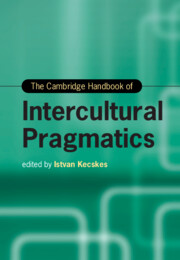Book contents
- The Cambridge Handbook of Intercultural Pragmatics
- Cambridge Handbooks in Language and Linguistics
- The Cambridge Handbook of Intercultural Pragmatics
- Copyright page
- Contents
- Figures
- Tables
- Acknowledgment
- Contributors
- Introduction The Rise of Intercultural Pragmatics
- Part I Theoretical Foundation
- Part II Key Issues in Intercultural Pragmatics Research
- Part III Interface of Intercultural Pragmatics and Related Disciplines
- Part IV Intercultural Pragmatics in Different Types of Communication
- Part V Language Learning
- Index
- References
Part IV - Intercultural Pragmatics in Different Types of Communication
Published online by Cambridge University Press: 29 September 2022
- The Cambridge Handbook of Intercultural Pragmatics
- Cambridge Handbooks in Language and Linguistics
- The Cambridge Handbook of Intercultural Pragmatics
- Copyright page
- Contents
- Figures
- Tables
- Acknowledgment
- Contributors
- Introduction The Rise of Intercultural Pragmatics
- Part I Theoretical Foundation
- Part II Key Issues in Intercultural Pragmatics Research
- Part III Interface of Intercultural Pragmatics and Related Disciplines
- Part IV Intercultural Pragmatics in Different Types of Communication
- Part V Language Learning
- Index
- References
Summary

- Type
- Chapter
- Information
- The Cambridge Handbook of Intercultural Pragmatics , pp. 525 - 738Publisher: Cambridge University PressPrint publication year: 2022
References
References
References
References
References
Acknowledgments: This chapter is funded by The Center for Linguistics and Applied Linguistics, Guangdong University of Foreign Studies, P.R. China, and also part of the research outcome by the “Business Discourse Research Innovation Team” funded by the Department of Education of Guangdong Province, China (No. 2021WCXTD007)



